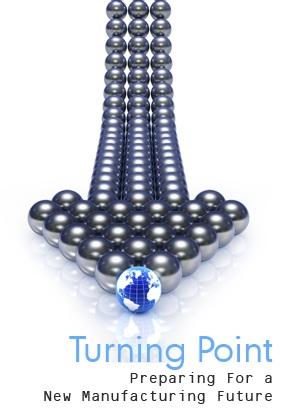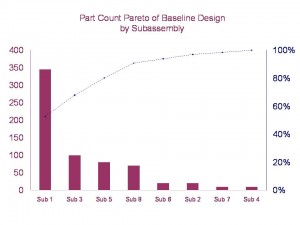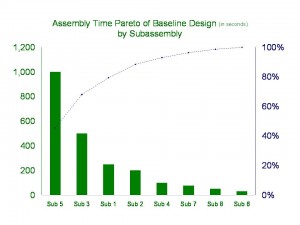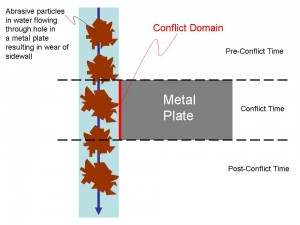Archive for the ‘How To’ Category
Anyone want to save $50 billion?
 I read a refreshing article in the Washington Post. Defense Secretary Robert M. Gates wants to save $20B per year on the Pentagon’s spend. I could kiss this guy!
I read a refreshing article in the Washington Post. Defense Secretary Robert M. Gates wants to save $20B per year on the Pentagon’s spend. I could kiss this guy!
Gates wants contracts scrutinized more closely for inefficiencies and unneeded overhead. He said the savings could be shifted to support U.S. troops around the globe. Pentagon officials said they’re looking for annual savings in the $400 billion spent on goods and services. They’re looking to save $20B, or 5%.
Gates has it right. The government must stop overpaying. But how? Gates suggests improved contract scrutiny to eliminate inefficiencies and unneeded overhead. He’s on the right track, but that’s not where the money is. Gates’ real target should be material cost – that’s where the money is. But, can material cost bring $20B savings? Yes.
Assume the Pentagon spends $100B on services and $300B on goods. The cost of those of goods falls into three buckets: labor, material, and overhead, where material cost makes up the lion’s share at 70%, or $210B. A 10% reduction in material cost brings $21B in savings, and gets Gates to his target. But how?
To get the savings, the Pentagon must drive the right behavior. They must must make suppliers submit a “should cost” with all proposals. The should cost is an estimated cost based on part geometries, materials, manufacturing processes used to create the parts, prevailing wage rates and machine rates, and profit. From these parameters, a should cost can be created in the design phase, without actually making the parts. So, the Pentagon will know what they should pay before the product is made. This cost analysis is based on real data, real machines, and real material costs. There is no escape for defense contractors. The cash cow is no longer.
Should costing will drive the design engineers to create designs that work better and cost less, something the defense industry thinks is impossible. They’re wrong. Given the tools, time, and training, the defense industry’s design engineering community can design out at least 25% of material cost, resulting in $50B+ in savings, more than twice Gates’ goal. Someone just has to teach them how.
Mr. Secretary, the non-defense world is ready to help. Just ask us. (But we’ll go after a 50% cost reduction.)
Back to Basics with DFMA
 About eight years ago, Hypertherm embarked on a mission to revamp the way it designed products. Despite the fact its plasma metal-cutting technology was highly regarded and the market leader in the field, the internal consensus was that product complexity could be reduced and thus made more consistently reliable, and there was an across-the-board campaign to reduce product development and manufacturing costs. Instead of entailing novel engineering tactics or state-of-the-art process change, it was a back-to-basics strategy around design for manufacture and assembly (DFMA) that propelled Hypertherm to meet its goals.
About eight years ago, Hypertherm embarked on a mission to revamp the way it designed products. Despite the fact its plasma metal-cutting technology was highly regarded and the market leader in the field, the internal consensus was that product complexity could be reduced and thus made more consistently reliable, and there was an across-the-board campaign to reduce product development and manufacturing costs. Instead of entailing novel engineering tactics or state-of-the-art process change, it was a back-to-basics strategy around design for manufacture and assembly (DFMA) that propelled Hypertherm to meet its goals.
The first step in the redesign program was determining what needed to change. A steering committee with representation from engineering, manufacturing, marketing, and business leadership spent weeks trying to determine what was required from a product standpoint to deliver radical improvements in both product performance and product economics. As a result of that collaboration, the team established aggressive new targets around robustness and reliability in addition to the goal of cutting the parts count and labor costs nearly in half.
Custom Model, exploring customized manufacturing (Mechanical Engineering Magazine)
 By reducing parts count and easing assembly, one plasma cutter maker explores customized manufacturing.
By reducing parts count and easing assembly, one plasma cutter maker explores customized manufacturing.
By Jean Thilmany, Associate Editor, Mechanical Engineering Magazine
Ask nearly any engineer or manufacturer about customized manufacturing and—to a person—they’ll all say the same thing: Have you heard the Dell story?
Dell is offered up again and again as the number one example of customized manufacturing done right and done successfully. Shortly after its founding in 1984, Dell began what it calls a configure-to-order approach to manufacturing. The computer company lets customers customize their own computers on the Dell Web site. Buyers select how much memory and disk space they desire and the resulting computer is manufactured and shipped to them.
The approach has helped the computer maker see skyrocket growth. Last year, it held the second-highest spot for desktops and laptops shipped, behind Hewlett Packard, according to market-share numbers from research firm International Data Corp. in Framingham, Mass.
Manufacturers—particularly electronics manufacturers—have long been taking notice. Many of them are investigating how the configure-to-order model could be put to use at their own companies. And some of them have implemented the method—along with the necessary software to get the job done—with great success.
Take Hypertherm Inc. of Hanover, N.H., maker of plasma metal cutting equipment. The company has recently started allowing customers to choose online from ten CNC Edge Pro product configurations, up from three configurations in the former product line, said John Sobr, head designer on the project.
Hypertherm recently redesigned its plasma metal cutting equipment to reduce part count by 27 percent while doubling the number of inputs available. Customers can now choose from ten product configurations.
DFMA Won’t Work
 Ask a company or team to do DFMA, and you get a great list of excuses on why DFMA is not applicable and won’t work. Product volumes are too low for DFMA, or too high; product costs are too low, or too high; production processes are too simple, or complex; production mix is too low, or too high. That’s all crap – just excuses to get out of doing the work. DFMA is applicable; it’s just a question of how to prioritize the work.
Ask a company or team to do DFMA, and you get a great list of excuses on why DFMA is not applicable and won’t work. Product volumes are too low for DFMA, or too high; product costs are too low, or too high; production processes are too simple, or complex; production mix is too low, or too high. That’s all crap – just excuses to get out of doing the work. DFMA is applicable; it’s just a question of how to prioritize the work.
To prioritize the work, take a look at product volumes. They’ll put you in the right ballpark. Here are three categories, low, medium, and high volume:
Pareto’s Three Lenses for Product Design
 Axiom 1 – Time is short, so make sure you’re working on the most important stuff.
Axiom 1 – Time is short, so make sure you’re working on the most important stuff.
Axiom 2 – You can’t design out what you can’t see.
In product development, these two axioms can keep you out of trouble. They’re two sides of the same coin, but I’ll describe them one at a time and hope it comes together in the end.
With Axiom 1, how do you make sure you’re working on the most important stuff? We all know it’s function first – no learning there. But, sorry design engineers, it doesn’t end with function. You must also design for lean, for cost, and factory floor space. Great. More things to design for. Didn’t you say time was short? How the hell am I going to design for all that?
Now onto the seeing business of Axiom 2. If we agree that lean, cost, and factory floor space are the right stuff, we must “see it” if we are to design it out. See lean? See cost? See factory floor space? You’re nuts. How do you expect us to do that?
Pareto to the rescue – use Pareto charts to identify the most important stuff, to prioritize the work. With Pareto, it’s simple: work on the biggest bars at the expense of the smaller ones. But, Paretos of what?
There is no such thing as a clean sheet design – all new product designs have a lineage. A new design is based on an existing design, a baseline design, with improvements made in several areas to realize more features or better function defined by the product specification. The Pareto charts are created from the baseline design to allow you to see the things to design out (Axiom 2). But what lenses to use to see lean, cost, and factory floor space?
Here are Pareto’s three lenses so see what must be seen:
To lean out lean out your factory, design out the parts. Parts create waste and part count is the surrogate for lean.
To design out cost, measure cost. Cost is the surrogate for cost.
To design out factory floor space, measure assembly time. Since factory floor space scales with assembly time, assembly time is the surrogate for factory floor space.
Now that your design engineers have created the right Pareto charts and can see with the right glasses, they’re ready to focus their efforts on the most important stuff. No boiling the ocean here. For lean, focus on part count of subassembly 1; for cost, focus on the cost of subassemblies 2 and 4; for floor space, focus on assembly time of subassembly 5. Leave the others alone.
Focus is important and difficult, but Pareto can help you see the light.
Workshop on Systematic DFMA Deployment
 Monday, June 14th, 2010
Monday, June 14th, 2010
1:00 p.m. to 5:00 p.m.
Pre‐Conference Workshop
2010 INTERNATIONAL FORUM on Design for Manufacturing and Assembly
Providence, Rhode Island, USA
Systematic DFMA Deployment
Real‐World Implementation and Hard Savings Make the Difference
Systematic DMFA Deployment is a straightforward, logical method to design out product cost and design in product function. Whether you want to learn about DFMA, execute a single project, implement across the company, or convince company leaders of DFMA benefits, this workshop is for you.
Systematic DMFA Deployment workshop attendees will learn how to:
- Select and manage projects
- Define resources and quantify savings
- Communicate benefits to company leadership
- Coordinate with lean and Six Sigma
- Get more out of DFMA software
Once you understand the principles of the Systematic DFMA Deployment milestone‐based system, you
will focus on activities that actually reduce product cost and avoid wheel‐spinning activities that create
distraction.
Workshop Fee: $95
Presenter
Dr. Mike Shipulski
For the past six years as Director of Engineering at Hypertherm, Inc., Mike has had the responsibilities of product development, technology development, sustaining engineering, engineering talent development, engineering labs, and intellectual property. Before Hypertherm, Mike worked in a manufacturing start‐up as the Director of Manufacturing and at General Electric’s R&D center as a Manufacturing Scientist during the start‐up phase of GE’s Six Sigma efforts. Mike received a Ph.D. in Manufacturing Engineering from Worcester Polytechnic Institute. Mike is the winner of the 2006 DFMA Supporter of the Year, and has been a keynote presenter at the DFMA Forum since 2006.
Blind To Your Own Assumptions
 Whether inventing new technologies, designing new products, or solving manufacturing problems, it’s important to understand assumptions. Assumptions shape the technical approach and focus thinking on what is considered (assumed) most important. Blindness to assumptions is all around us and is a real reason for concern. And the kicker, the most dangerous ones are also the most difficult to see – your own assumptions. What techniques or processes can we use to ferret out our own implicit assumptions?
Whether inventing new technologies, designing new products, or solving manufacturing problems, it’s important to understand assumptions. Assumptions shape the technical approach and focus thinking on what is considered (assumed) most important. Blindness to assumptions is all around us and is a real reason for concern. And the kicker, the most dangerous ones are also the most difficult to see – your own assumptions. What techniques or processes can we use to ferret out our own implicit assumptions?
By definition, implicit assumptions are made without formalization, they’re not explicit. Unknowingly, fertile design space can be walled off. Like the archeologist digging on the wrong side of they pyramid, dig all he wants, he won’t find the treasure because it isn’t there. Also with implicit assumptions, precious time and energy can be wasted solving the wrong problem. Like the auto mechanic who replaced the wrong part, the real problem remains. Both scenarios can create severe consequences for a product development project. (NOTE: the notion of implicit assumptions is closely related to the notion of intellectual inertia. See Categories – Intellectual Inertia for a detailed treatment.)
Now the tough part. How to identify your own implicit assumptions? When at their best, the halves of our brains play nicely together, but never does either side rise to the level of omnipotence. It’s impossible to stand outside ourselves and watch us make implicit assumptions. We don’t work that way. We need some techniques.
Narrow, narrow, narrow. The probability of making implicit assumptions decreases when the conflict domain is narrowed.
Narrow in space and time to make the conflict domain small and assumptions are reduced.
Narrow the conflict domain in space – narrow to two elements of the design that aren’t getting along. Not three elements – that’s one too many, but two. Narrow further and make sure the two conflicting elements are in direct physical contact, with nothing in between. Narrow further and define where they touch. Get small, really small, so small the direct contact is all you see. Narrowing in space reduces space-based assumptions.
Narrow the conflict domain in time – break it into three time domains: pre-conflict time, conflict time, post-conflict time. This is a foreign idea, but a powerful one. Solutions are different in the three time domains. The conflict can be prevented before it happens in the pre-conflict time, conflict can be dealt with while it’s happening (usually a short time) in the conflict time, and ramifications of the conflict can be cleaned up in the post-conflict time. Narrowing in time reduces time-based assumptions.
Assumptions narrow even further when the conflict domain is narrowed in time and space together, limiting them to the where and when of the conflict. Like the intersection of two overlapping circles, the conflict domain is sharply narrowed at the intersection of space and time – a small space over a short time.
It’s best to create a picture of the conflict domain to understand it in space and time. Below (click to enlarge) is an example where abrasives (brown) in a stream of water (light blue) flow through a hole in a metal plate (gray) creating wear of the sidewall (in red). Pre-conflict time is before the abrasive particles enter the hole from the top; conflict time is while the particles contact the sidewall (conflict domain in red); post-conflict time is after the particles leave the hole. Only the right side of the metal place is shown to focus on the conflict domain. There is no conflict where the abrasive particles do not touch the sidewall.
Even if your radar is up and running, assumptions are tough to see – they’re translucent at best. But the techniques can help, though they’re difficult and uncomfortable, especially at first. But that’s the point. The techniques force you to argue with yourself over what you know and what you think you know. For a good start, try identify the two elements of the design that are not getting along, and make sure they’re in direct physical contact. If you’re looking for more of a challenge, try to draw a picture of the conflict domain. Your assumptions don’t stand a chance.
With Innovation, It’s Trust But Verify.
 Your best engineer walks into your office and says, “I have this idea for a new technology that could revolutionize our industry and create new markets, markets three times the size of our existing ones.” What do you do? What if, instead, it’s a lower caliber engineer that walks into your office and says those same words? Would you do anything differently? I argue you would, even though you had not heard the details in either instance. I think you’d take your best engineer at her word and let her run with it. And, I think you’d put less stock in your lesser engineer, and throw some roadblocks in the way, even though he used the same words. Why? Trust.
Your best engineer walks into your office and says, “I have this idea for a new technology that could revolutionize our industry and create new markets, markets three times the size of our existing ones.” What do you do? What if, instead, it’s a lower caliber engineer that walks into your office and says those same words? Would you do anything differently? I argue you would, even though you had not heard the details in either instance. I think you’d take your best engineer at her word and let her run with it. And, I think you’d put less stock in your lesser engineer, and throw some roadblocks in the way, even though he used the same words. Why? Trust.
Innovation is largely a trust-based sport. We roll the dice on folks that have already put it on the table, and, conversely, we raise the bar on those that have not yet delivered – they have not yet earned our trust. Seems rational and reasonable – trust those who have earned it. But how did they earn your trust the first time, before they delivered? Trust.
There is no place for trust in the sport of innovation. It’s unhealthy. Ronald Reagan had it right:
Trust, but verify.
As we know, he really meant there was no place for trust in his kind of sport. Every action, every statement had to be verified. The consequences so cataclysmic, no risk could be tolerated. With innovation consequences are not as severe, but they are still substantial. A three year, multi-million (billion?) dollar innovation project that returns nothing is substantial. Why do we tolerate the risk that comes with our trust-based approach? I think it’s because we don’t think there’s a better way. But there is. What we need is some good, old-fashioned verification mixed in with our innovation.
When the engineer comes into your office and says she can reinvent your industry, what do you ask yourself? What do you want to verify? You want to know if the new idea is worth a damn, if it will work, if there are fundamental constraints in the way. But, unfortunately for you, verification requires knowledge of the physics, and you’re no physicist. However, don’t lose hope. There are two simple tactics, non-technical tactics, to help with this verification business.
First – ask the engineers a simple question, “What conflict is eliminated with the new technology?” Good, innovative technologies eliminate fundamental, long standing conflicts. These long standing conflicts limit a technology in a way that is so fundamental engineers don’t even know they exist. When a fundamental conflict is eliminated, long held “design tradeoffs” no longer apply, and optimizing is replaced by maximizing. With optimizing, one aspect of the design is improved at the expense of another. With maximizing, both aspects of the design are improved without compromise. If the engineers cannot tell you about the conflict they’ve eliminated, your trust has not been sufficiently verified. Ask them to come back when they can answer your question.
Second – when they come back with their answer, it will be too complex to be understood, even by them. Tell them to come back when they can describe the conflict on a single page using a simple block diagram, where the blocks, labeled with everyday nouns, represent parts of the design intimately involved with the conflict, and the lines, labeled with everyday verbs, represent actions intimately involved with the conflict. If they can create a block diagram of the conflict, and it makes sense to you, your trust has been sufficiently verified. (For a post with a more detailed description of the block diagrams, click on “one page thinking” in the Category list.)
Though your engineers won’t like it at first, your two-pronged verification tactics will help them raise their game, which, in turn, will improve the risk/reward ratio of your innovation work.
Tools for innovation and breaking intellectual inertia
 Everyone wants growth – but how? We know innovation is a key to growth, but how do we do it? Be creative, break the rules, think out of the box, think real hard, innovate. Those words don’t help me. What do I do differently after hearing them?
Everyone wants growth – but how? We know innovation is a key to growth, but how do we do it? Be creative, break the rules, think out of the box, think real hard, innovate. Those words don’t help me. What do I do differently after hearing them?
I am a process person, processes help me. Why not use a process to improve innovation? Try this: set up a meeting with your best innovators and use “process” and “innovation” in the same sentence. They’ll laugh you off as someone that doesn’t know the front of a cat from the back. Take your time to regroup after their snide comments and go back to your innovators. This time tell them how manufacturing has greatly improved productivity and quality using formalized processes. List them – lean, Six Sigma, DFSS, and DFMA. I’m sure they’ll recognize some of the letters. Now tell them you think a formalized process can improve innovation productivity and quality. After the vapor lock and brain cramp subsides, tell them there is a proven process for improved innovation.
A process for innovation? Is this guy for real? Innovation cannot be taught or represented by a process. Innovation requires individuality of thinking. It’s a given right of innovators to approach it as they wish, kind of like freedom of speech where any encroachment on freedom is a slippery slope to censorship and stifled thinking. A process restricts, it standardizes, it squeezes out creativity and reduces individual self worth. People are either born with the capability to innovate, or they are not. While I agree that some are better than others at creating new ideas, innovation does not have to be governed by hunch, experience and trial and error. Innovation does not have to be like buying lottery tickets. I have personal experience using a good process to help stack the odds in my favor and help me do better innovation. One important function of the innovation process is to break intellectual inertia.
Intellectual inertia must be overcome if real, meaningful innovation is to come about. When intellectual inertia reigns, yesterday’s thinking carries the day. Yesterday’s thinking has the momentum of a steam train puffing and bellowing down the tracks. This old train of thought can only follow a single path – the worn tracks of yesteryear, and few things are powerful enough to derail it. To misquote Einstein:
The thinking that got us into this mess is not the thinking that gets us out of it.
The notion of intellectual inertia is the opposite of Einstein’s thinking. The intellectual inertia mantra: the thinking that worked before is the thinking that will work again. But how to break the inertia? Read the rest of this entry »
Reducing the risk of Innovation
 Though we can’t describe it in words, or tell someone how to do it, we all know innovation is good. Why is it good? Look at the causal chain of actions that create a good economy, and you’ll find innovation is the first link.
Though we can’t describe it in words, or tell someone how to do it, we all know innovation is good. Why is it good? Look at the causal chain of actions that create a good economy, and you’ll find innovation is the first link.
When innovation happens, a new product is created that does something that no other product has done before. It provides a new function, it has a new attribute that is pleasing to the eye, it makes a customer more money, or it simply makes a customer happy. It does not matter which itch it scratches, the important part is the customer finds it valuable, and is willing to pay hard currency for it. Innovation does something amazing, it results in a product that creates value; it creates something that’s worth more than the sum of its parts. Starting with things dug from the ground or picked from it – dirt (steel, aluminum, titanium), rocks (minerals/cement/ceramics), and sticks (wood, cotton, wool), and adding new thinking, a product is created, a product that customers pay money for, money that is greater than the cost of the dirt, rocks, sticks, and new thinking. This, my friends, is value creation, and this is what makes national economies grow sustainably. Here’s how it goes.
Customers value the new product highly, so much so that they buy boatloads of them. The company makes money, so much so stock price quadruples. With its newly-stuffed war chest, the company invests with confidence, doing more innovation, selling more products, and making more money. An important magazine writes about the company’s success, which causes more companies to innovate, sell, and invest. Before you know it, the economy is flooded with money, and we’re off to the races in a sustainable way – a way based on creating value. I know this sounds too simplistic. We’ve listened too long to the economists and their theories – spur demand, markets are efficient, and the world economy thing. This crap is worse than it sounds. Things don’t have to be so complicated. I wish economists weren’t so able to confuse themselves. Innovate, sell, and invest, that’s the ticket for me.
Innovation – straightforward, no, easy, no. Innovation is scary as hell because it’s risky as hell. The risk? A company tries to develop a highly innovative product, nothing comes out the innovation tailpipe, and the company has nothing for its investment. (I can never keep the finance stuff straight. Does zero return on a huge investment increase or decrease stock price?) It’s the tricky risk thing that gets in the way of innovation. If innovation was risk free, we’d all be doing it like voting in Chicago – early and often. But it’s not. Although there is a way to shift the risk/reward ratio in our favor.
After doing innovation wrong, learning, and doing it less wrong, I have found one thing that significantly and universally reduces the risk/reward ratio. What is it?
Know you’re working on the right problem.
Work on the right problem? Are you kidding? This is the magic advice? This is the best you’ve got? Yes.
If you think it’s easy to know you’re working on the right problem, you’ve never truly known you were working on the right problem, because this type of knowing is big medicine. Innovation is all about solving a special type of problem, problems caused by fundamental conflicts and contradictions, things that others don’t know exist, don’t know how to describe, or define, let alone know how to eliminate. I’m talking about conflicts and contradictions in the physics sense – where something must be hot and cold at the same time, something must be big while being small, black while white, hard one instant, and soft the next. Solve one of those babies, and you’ve innovated yourself a blockbuster product.
In order to know you’re working on the right problem (conflict or contradiction), the product is analyzed in the physics sense. What’s happening, why, where, when, how? It’s the rule (not the exception) that no one knows what’s really going on, they only think they do. Since the physics are unknown, a hypothesis of the physics behind the conflict/contradiction must be conjured and tested. The hypothesis must be tests analytically or in the lab. All this is done to define the problem, not solve it. To conjure correctly, a radical and seemingly inefficient activity must be undertaken. Engineers must sit at their desk and think about physics. This type of thinking is difficult enough on its own and almost impossible when project managers are screaming at them to get off their butts and fix the problem. As we know, thinking is not considered progress, only activity is.
After conjuring the hypothesis, it’s tested to prove or disprove. If dis-proven, back to the desk for more thinking. If proven, the conflict/contradiction behind the problem is defined, and you know you’re working on the right problem. You have not solved it, you’ve only convinced yourself you’re working on the right one. Now the problem can be solved.
Believe it or not, solving is the easy part. It’s easy because the physics of the problem are now known and have been verified in the lab. We engineers can solve physics problems once they’re defined because we know the rules. If we don’t know the physics rules off the top of our heads, our friends do. And for those tricky times, we can go to the internet and ask Google.
I know all this sounds strange. That’s okay, it is. But it’s also true. Give your engineers the tools, time and training to identify the problems, conflicts, and contradictions and innovation will follow. Remember the engineering paradox, sometimes slower is faster. And what about those tools for innovation? I’ll save them for another time.
DFA Saves More than Six Sigma and Lean
I can’t believe everyone isn’t doing Design for Assembly (DFA), especially in these tough economic times. It’s almost like CEOs really don’t want to grow stock price. DFA, where the product design is changed to reduce the cost of putting things together, routinely achieves savings of 20-50% in material cost, and the same for labor cost. And the beauty of the material savings is that it falls right to the bottom line. For a product that costs $1000 with 60% material cost ($600) and 10% profit margin ($100), a 10% reduction in material cost increases bottom line contribution by 60% (from $100 to $160). That sounds pretty good to me. But, remember, DFA can reduce material cost by 50%. Do that math and, when you get up off the floor, read on.
Unfortunately for DFA, the savings are a problem – they’re too big to be believed. That’s right, I said too big. Here’s how it goes. An engineer (usually an older one who doesn’t mind getting fired, or a young one who doesn’t know any better) brings up DFA in a meeting and says something like, “There’s this crazy guy on the web writing about DFA who says we can design out 20-50% of our material cost. That’s just what we need.” A pained silence floods the room. One of the leaders says something like, “Listen, kid, the only part you got right is calling that guy crazy. We’re the world leaders in our field. Don’t you think we would have done that already if it was possible? We struggle to take out 2-3% material cost per year. Don’t talk about 20-50% because is not possible.” DFA is down for the count.
Also unfortunate is the name – DFA. You’ve got to admit DFA doesn’t roll off the tongue like six sigma which also happens to sound like sex sigma, where DFA does not. I think we should follow the lean sigma trend and glom some letters onto DFA so it can ride the coat tails of the better known methodologies. Here are some letters that could help:
Lean DFA; DFA Lean; Six Sigma DFA; Six DFA Sigma (this one doesn’t work for me); Lean DFA Sigma
Its pedigree is also a problem – it’s not from Toyota, so it can’t be worth a damn. Maybe we should make up a story that Deming brought it to Japan because no one in the west would listen to him, and it’s the real secret behind Toyota’s success. Or, we can call it Toyota DFA. That may work.
Though there is some truth to the previous paragraphs, the main reason no one is doing DFA is simple:
No one is asking the design community to do DFA.
Here is the rationalization: The design community is busy and behind schedule (late product launches). If we bother them with DFA, they may rebel and the product will never launch. If we leave them alone and cross our fingers, maybe things will be all right. That is a decision made in fear, which, by definition, is a mistake.
The design community needs greatness thrust upon them. It’s the only way.
Just as the manufacturing community was given no choice about doing six sigma and lean, so should the design community be given no choice about doing DFA.
No way around it, the first DFA effort is a leap of faith. The only way to get it off the ground is for a leader in the organization to stand up and say “I want to do DFA.” and then rally the troops to make it happen.
I urge you to think about DFA in the same light as six sigma or lean: If your company had a lean or six sigma project that would save you 20-50% on your product cost, would you do it? I think so.
Who in your organization is going to stand up and make it happen?




 Mike Shipulski
Mike Shipulski